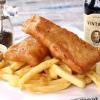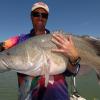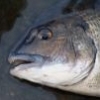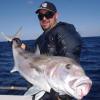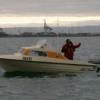
scorpion
-
Content Count
609 -
Joined
-
Last visited
-
Days Won
2
Reputation Activity
-
 scorpion reacted to Des in WEATHER or NOT ???
scorpion reacted to Des in WEATHER or NOT ???
The Yellow Fin Whiting season is fast approaching. As the seasons and weather conditions change we have to think about and adapt to the changing behaviours of the Yellow Fin Whiting.
The most important thing for successful YFW lure fishing is knowing the fish!
It’s physiology. It’s habitats and ecosystems. Also it’s behaviour in all weather conditions and seasons.
The next most important thing for successful YFW lure fishing is knowing your spots. The geography and terrain.
There is always a right spot, for every weather and tide conditions. When do the fish go to a given spot? In what weather? On which tide? And what food is available there in these conditions?
The least important thing for successful YFW lure fishing is … lures !!!
Find the fish first. Before worrying about finding the right lure and technique.
Your chances of success will depend on assessing the weather and tide conditions on a given day and then understanding the behaviour of YFW in those conditions. YFW will be found in different locations, in different weather and tide conditions.
There is nearly always a good fishing spot available. Almost regardless of the weather conditions.
We are lucky to have the two gulfs and the Yorke Peninsula. It provides us with a variety of options regardless of the weather and which way the wind blows.
These are some weather and location factors that I consider, before I go lure fishing for YFW
TEMPERATURE
Early in the season air and water temperatures are critical for lure fishing. With the rising temperature their metabolism, muscle functions and locomotion increases.
At the start of Spring, I usually pick a day at the end of a series of warmer days. The water would have warmed up a little by then. It takes a while for the water temperatures to change due to thermal lag. And even then I prefer fishing the warmer afternoon on these sunnier warmer days. A smaller tide on these days is a bonus. Less water to warm up in the shallows. Bigger tides can bring in cooler deeper water into the warm shallows. However this dynamic is ever changing and does go into reverse in the hottest months. Stay alert to the different water temperatures at different water depths at different times of the year.
By November, water temperatures are now consistently over 20c. Low water temperatures and a low metabolism in the YFW is, no longer a factor. A chilly morning in summer may just dull the fish’s appetite. But by mid day as they gather in the deeper areas after the morning run off they will be back to their aggressive best.
Yes the water temperature can get too hot after a hot spell. Then the obvious thing is to fish the cooler mornings.
Also pick deeper water locations during hot weather spells. Where the fish can find some relief from the hotter surface water temperatures of the shallows. If fishing the afternoon incoming tide, you will need to fish back deeper in the tide. Where the water is cooler on those very hot days.
…… Early in the season blades work better, as fish stay deeper and are less likely to rise for a surface lure.
WIND
Given that water temperatures are good, wind is the next most important factor for stimulating YFW surface feeding.
The perfect wind for lure fishing YFW on an open sand flat, is in the 6 to 12 knots range. Perfect to stimulate YFW feeding as they feel a lot safer under the cover of a heavy ripple or light chop on the surface of the water. The chop sufficiently obscures their vision, so they are not too discerning with lures in these conditions. Although too windy and too choppy, will stir up the sand and dirty the water. Fish will move to more protected and cleaner water.
Strong winds are okay. In fact can be brilliant for concentrating fish in certain spots.Your spot selection in these conditions becomes critical. The geography of the Yorke Peninsula and gulfs gives us a myriad of options regardless of which direction the wind is blowing. With the gulfs and peninsula, you will always have a section of coast with an offshore wind.
In strong winds, a lot more fish are gathered on the leeward coast, as they move away from the open rougher waters.
Less floating weed and accumulated weed wracks on the leeward side is also a bonus. So strong winds are great for concentrating fish in certain areas.
…. A video of the ideal wind when lure fishing YFW
…. Both fish and their predators can be found sheltering from the wind in mangrove areas.
HABITATS
The varied marine habitats and terrain also provides a few options for windy days. There are habitats that provide sheltered areas regardless of onshore strong winds. A spot behind a mangrove forrest wall will have less chop and cleaner water. This area attracts and holds a lot more fish as they shelter from the rougher conditions outside. Often these strong on shore winds will produce a bigger tide, due to a storm surge. The fish take advantage of this as it provides access to fresh feeding areas around samphire beds behind the mangrove wall.
Flooded in shore lagoons on a high tide are calmer and protected from the heavy churning chop. They will hold more fish in windier conditions. There are plenty of sandy bays and coves on the Peninsula that exist because they are sheltered, always in the leeward side of the prevailing strong winds. The water here is always cleaner and clearer, with fish more abundant in this location during windy conditions. Persistent strong winds are good. Don’t curse them, use them to your advantage.
You may need to travel to the other side of a gulf to do this. Or even a trip down to the beautiful calm and sheltered waters of Hardwicke Bay, Point Souttar and Corny Point.
… An area sheltered by mangrove walls, that will hold more fish in stronger onshore winds.
…. These fish were taken at the entrance of some mangrove areas
TERRAIN
Windy days on the open sand flats, will find fish sheltering in the deeper channels that will offer protection from the wind chop in the shallows. You will also find the leeward protected side of weed banks will hold more fish. Conversely should the winds be very light the windward side of a weed bank will have more food stirred up and hold more fish. What ever the wind does, there is a suitable spot to be.
A windy day bonus - long casts downwind, always catch more fish. I avoid fishing on calm days if I can help it.
… Channels and weed banks provide some shelter
TIDE
Any water movement provides a feeding stimulus for YFW. The tides are the most common cause of movement and will always influence fish behaviour.
However even on a dead dodge tide, SW wind surges, afternoon seabreezes, or changes in atmospheric pressure can create enough stimulating water movement, regardless of the poor tide predictions. A small stimulus on an otherwise listless day often produces a disproportionate stimulatory reaction from the fish.
Given that the main opening to the Gulfs face SW most tides will be boosted by a SW wind. Low atmospheric pressure will also draw in a larger tide. Factor these in to the published tide predictions, as there always is always a great deal of variation in tide heights on the sandflats.
… An old tide book explaining the factors that can effect tide height.
The small dodge tides can be taken advantage of. The small tide holds and concentrate fish in larger numbers in a smaller area, rather than a big tide dispersing them over a large area. At times fishing these conditions can be more like “shooting fish in a barrel”.
Big tides provide fish accessibility to new feeding habitats. Big YFW love the small Haswell crabs that live in the Samphire beds, behind the mangrove forests. This food becomes accessible to the YFW during the big tides that cover the Samphire beds. The YFW are a much easier target when they make their way in and out of the samphire beds, in a dropping big tide.
Wether it be a Dodge tide or a big Spring tide, or light winds or strong winds, you will always be presented with a few different fishing opportunities, with the different conditions.
…. Some of the largest YFW are taken on the biggest tides when they were chasing Haswell crabs in the Samphire beds
…. Crabs in the gut contents of YFW
CURRENTS
Some locations with deeper major channels, that drain the sandflats have increased water flows. The localised currents, can stimulate fish feeding. It is a good location in a dodge tide when these channels can amplify water little water movement there is in the tide.
These channels will usually bring in water of a temperature that offsets the existing shallow water temperatures. The deeper water also provides a refuge in either temperature extreme. In ambient temperature conditions they are also the tidal highways for fish.
There are also major ocean currents that come into play. In winter the major Leeuwin current flows across from WA and effects the lower Spencers Gulf water temperatures. Boston Bay in Pt. Lincoln is well known for winter YFW.
I have caught bags of YFW in the middle of winter on southern Yorkes when the locals tell me you won’t see them till October.
A Northerly wind with a following Westerly change will flick in the warm water flows of the Leeuwin current and bring with it schools of YFW. Maintain a fishing log. They are a great reference.
…. The Leeuwin current brings warm water temperatures to the southern Spencers Gulf in winter
SUNSHINE !!!
On sunny days you catch more fish! It probably is the extra warmth and the better visibility of the lures. But it does not matter if you don’t catch fish theses beautiful days !
… It is always good fishing in the sunshine
So you either you pick the best weather days for your regular spot, or you pick a new spot to suit the weather and tides on the day.
One way or another you should be able to catch a good feed of YFW on lures. Regardless of the weather.
Tight Lines,
Cheers, Des
-
 scorpion reacted to Des in DONKEYS on the DODGE TIDE
scorpion reacted to Des in DONKEYS on the DODGE TIDE
Regular post readers will know I like to fish the dodge tides for Yellow Fin Whiting .
I cover a variety of reasons in detail, in this previous post:
.
One very good reason, is that you will regularly find better quality fish on the dodge tide.
YFW movements and feeding are highly influenced by the tide. Revolving around the largest tide of the day, they tend to have a 24 hour digestive and feeding cycles.
So even when the tides do not move much on the dodge, they will still have a need to feed within their cycles. The larger YFW have greater food needs and will generally preference a bigger meal such as juvenile prawns or clickers.
With the small dodge tide their feeding will be concentrated to the smaller area, covered by little water flooding in. They will be easier to find.
The terrain/substrate that holds their preferred food will naturally attract a higher concentration of larger YFW.
That terrain you can feel under foot. The softer food holding substrate.
The small tide movement, along with a deeper low tide, holds water over these prime feeding grounds longer. It provides for prolonged access to this zone for both fish and fisher person.
A better explanation of productive terrain is in this post :
.
The dodge tide on Monday with a High of 1.77 mt @ 8.15am and a Low of 0.97 mt @ 11.36pm provided a long drawn out, run off tide. With a prolonged spell under water, of some prime food holding areas. It looked like an ideal tide and I set off fishing.
YFW are always stimulated by tide movement to feed. These tides do not provide much of that stimulus. However there are other factors that come into play.
.
The day started slowly without a strike for the first hour. The warmth of the day gradually started to take effect and the first to stir were some small Whiting.
With the warming arvo came an arvo seabreeze, as well as a predicted strengthening southerly wind. YFW love a heavy rippled surface to take cover under and lose their feeding inhibitions. The bite picked up strongly and catches were now steady. In the constrictions of the upper gulfs any lower gulf southerly wind can force water up. A wind tide pushes in. It further stimulated the YFW and kept the feeding grounds covered with a perfect level of water for a wading fisherman.
.
I caught my bag of 20 in good time. This situation regularly provides quality fish, with10 of the fish ranging from 38 to 41cm. Most of the remaining 10 fish were around 35cm.
Sugapen 95 was the most successful lure. Then again I did not need to use a lot of variety.
The new Sugapen Splash caught it’s share when the afternoon breeze picked up. This is shaping up as the perfect lure for that strong summer afternoon breeze that kicks up a bit of chop.
A few were also taken on the Ecogear ZX, when I was forced to go subsurface as a pack of persistent juvenile seagulls are yet to learn lures don’t taste good.
.
Hopefully we have some more fine weather for the next dodge tide.
Tight lines all.
Cheers, Des
-
 scorpion reacted to Wert in BEWARE the BAG SNATCHERS IN A CUP DAY CROWD
scorpion reacted to Wert in BEWARE the BAG SNATCHERS IN A CUP DAY CROWD
Nice work putting Bob in his place, clearly needed to have a lesson in manners, the upper gulf can be full of them this time of year, I've had up to half a dozen of the buggers between 3 to 7 foot visible circling in the burley (in the boat thankfully) at this same time of off Price.
Bronzies around the 5-6 foot mark are 4 out of 5 times exceptional eating in my experience with a head and tail removed trunk of around a metre being ideal for turning into steaks and "fillets", Bob looked a little on the small side (tasty but soft v excellent texture but too much ammonia taste) and let's face it, those YFWs are probably even better, I'd take them over KGs.
Well done on your "poor" day fishing... I mean most would kill for that but I've seen your other write ups so you get a pass on that, hope you have plenty of good trips this season, I love following your flats adventures always but being banged up post back surgery and with fishing out of the equation until new years I need this.
-
 scorpion reacted to Des in CHAIN REACTIONS with CHANGING SEASONS
scorpion reacted to Des in CHAIN REACTIONS with CHANGING SEASONS
Warmer water early in the season will certainly bring them into the metro areas earlier. I saw a post from Brighton Tackle claim they had been sighted locally.
As I have previously mentioned the ongoing heavy netting of this species over winter in the last few years is having a significant detrimental impact on the overall stock status. Hopefully they are resilient and bounce back.
-
 scorpion reacted to Des in TERRAIN: HIGHWAYS TO THE FEEDING ZONES
scorpion reacted to Des in TERRAIN: HIGHWAYS TO THE FEEDING ZONES
TERRAIN: HIGHWAYS TO THE FEEDING ZONES … You can sign along to this post !
Yellow Fin Whiting have been showing up in good numbers in both gulfs recently.
But you still need to find them, and fish the right spots … at the right stage in the tide.
YFW are always on the move. Actively feeding on a moving tide. Both in and out going tides.
But there are dead transit zones, over which they will pass through without providing you much of a chance to catch them. These are merely the … Highways to the Feeding zones.
The feeding zones is where you want to be fishing.
In each YFW Habitat there are transit zones and feeding zones.
In the upper gulfs the coastal environment contains a lot more mangroves and samphire beds. Nearest to shore and onshore are the Salt bushes and Samphire bed areas.
On many stretches of the upper gulfs they will also be a mangrove forrest wall.
Through these mangrove forrest flow many small tidal creeks and channels, that pour in and out onto Sandflats. The Sandflats drain out, eventually meeting the ribbon grass weed beds.
In the lower gulfs, the terrain is slightly different without Mangroves and less Samphire.
They are replaced by open sandflats, sometimes with a little scattered reef, and banks of fine seagrass weed beds, that drain out to a weedline of ribbon grass.
Each area has it’s own characteristics and features, which influence the movements and feeding behaviour of the YFW. The all have their transit zones and their feeding zones.
.
WEED LINES.
We start at the deep end, the weedline. This is the first of the habitats in which we find YFW.
The deeper seaside of the sand flats are always bordered by the weed line of sea grass beds. These are usually Ribbon weed or tape weed beds (Posidonia varieties). Often this will be where the bottom of the low tides hold. And were the YFW take refuge on the low tides.
In the lower sections of the gulfs, their cousins the King George Whiting also keep them company at the weed line. Along with many a Flathead too.
The best spots for land based KGW are the weedline areas that receives a natural berley stream from sandy shallow drains, running off the sand flats.
This habitat is also a favourite for Flathead, which take cover in the weed edges and like to ambush baitfish straying too close.
You will find the larger YFW hanging around here, mixing it with the Flathead and KGW. Large YFW have the speed and morphology to take minnows at the weedline. They are able to chase them down along with any Shrimp that may have come out of the sheltering grasses.
The barrier like structure of the weed beds will mean there is always some channeling through the weed beds, caused by the tidal flows. These channels are the main flow areas during tidal movements, on and off the sandflats.
Focus your fishing at these channel openings, both at the bottom and at the start of the tide.
And in a dodge tide, it is the only place to be. The minimal water flows of a dodge tide will be greatest at these channels, and so stimulate the YFW to feed in that area.
~ King George Whiting, Yellow Fin Whiting and Flathead all found down on the weedline.
~ Find the water flow and fish at the channel openings
SANDFLATS
Sandflats … are never Flat !!!
Sand flats don’t always slope seawards in a continuous gentle gradient. They is more often a series of ridges, gutters, bowls, channels and steps leading down to the weedline.
These are not necessarily dramatically obvious. A 4” to 5 inch depth difference is a significant change in these shallow sandflats.
These structures and variations in the sandflat terrain are the most obvious fish holding areas. The slightly deeper areas of the shallows, are the first areas that YFW will retreat into on a dropping tide, or swim into and hold in, on the incoming tide.
Fish always hold at steps and drops on the sandflats, wether it be the run in or run off.
They prefer to feed on the shallow edges of any deeper water areas rather than in the deep water itself.
If in a fast flowing channel focus on the slow side of a bend in the channel. It is where food would naturally settle and fish will feed. It is where the benthic organisms colonise more with out fear of being swept out by a fast moving tide.
Shallow weed beds of finer bladed, lawn like, seagrasses ( Zostera varieties) are often found on the more open flats lower in the gulfs. They are important for the movements of YFW during the tidal flows. In very shallow water YFW will tend to favour moving along the weed bed edges and take cover in the weed beds. It is an ideal spot to target them in ankle deep water. The water is always a bit deeper alongside the edges of these fine grass weed beds.
Should the wind be a bit strong, YFW will hold on the Leeward side of these beds a bit more. And on light winds with gentle lapping waves, the windward side of these weed beds.
~ The small variations on the sandflats hold the fish
SUBSTRATE on SANDFLATS
Regardless of upper or lower gulf areas, you should identify the substrate that you are fishing on.
As a wading fisherman you can feel and identify the different substrate underfoot.
It is simply either, coarse, gravelly and hard, or soft, silty, and sandy.
I usually move on quickly from the coarser, gravelly areas and onto the finer, siltier, sandy areas.
Coarse gravelly limestone or shell grit areas are not as productive. They do not hold the YFW food so don’t hold the YFW long. It often is a faster flowing area and a transit zone for fish.
You will still catch the odd few YFW as they use it as a highway to the feeding zones. But they won’t hold and feed there.
The feeding zones are characterised by finer, softer, siltier sand beds. Which holds a lot more YFW food. This is where all the benthic dwelling creatures, like cockles, worms and clickers live. All the juvenile prawns that we see leaping around on the surface at night as nocturnals, now bury themselves for the day in the soft sand and silt.
YFW linger a lot longer in these softer sandy areas searching for and feeding on the food it holds.
MANGROVES
Bordering the sandflats on the shoreside in the upper gulfs are often mangrove forests. Amongst the mangrove forest there are clear water ways that channel the considerable tidal movement experienced in the upper gulfs. The tides flow through tidal creeks and mangrove openings and into the samphire beds, or out onto the sandflats. These mangrove openings will hold a greater concentration of fish when the tide is moving.
At times the thick growth and dense mangrove canopy can totally conceal an opening. There are however some tell tale signs of a concealed creek or channel. Ever wondered about those Shags, that regularly congregate on certain mangrove trees overlooking the sand flats. It’s the Shag breakfast club. The shags are there because there is food flowing out there. Minnows, Shrimp and Prawns are being brought out on the falling tide through a creek concealed by the mangrove canopy. The larger YFW are not threatened by the Shags and will also hang out the front of these spots.
~ Mangrove Openings have high flow rates and hold fish
SAMPHIRE BEDS
Once past the mangroves there are obvious narrow channels through the samphire beds. These are invariably gravelly rarely holding benthic species. But they will hold and concentrate YFW passing through that can’t help but see your offering. The YFW like to move up into the muddier samphire bed areas primarily to feed on Haswells crabs and small mud cockles. This is a highway on which you can actually take a toll.
Great spots are Junctions, like one I nicknamed “Gepps X”. It does bring to together a concentration of fish. Even if only a relatively short time at the right time of tide. You can even catch YFW by hand at night in these narrow and restricted spaces.
Google satellite images are the most useful tool you have to help you find the spots and plan your strategy for the incoming and outgoing tide.
~ Fish move into the channels of the Samphire beds
OPPORTUNISTS
This has nothing to do with the terrain. Try casting lures around feeding Eagle Rays on the sandflats.
The YFW often hang around feeding Rays hoping to pounce on food that the Ray has dislodged.
They are in a switched on and opportunistic feeding mode, ready to pounce.
Just offer them your lure instead! This has worked well on a few occasion.
And in the better years now past, when the YFW biomass was not that badly decimated by the pro netting activities, they would also hang around swimmers on metro beaches, in the hope of some dislodged food.
.
~ A nice Catch wading for YFW
As keen Hunters and Gathers, we always need to stay alert to and aware of all the features in the fish’s habitats and how they will effect our catch rate.
Tight lines all.
Cheers, Des
-
 scorpion reacted to Des in DODGY DAYS
scorpion reacted to Des in DODGY DAYS
Fished the dodge tide on Saturday.
Unfortunately the wind and air pressure conspired to negate what little water movement there was. Rather than accentuate it which is what I was expecting.
Nonetheless got 16 from 32 to 40cm. Sunday was a blow out !
-
 scorpion reacted to portunus in Under wader wear
scorpion reacted to portunus in Under wader wear
If its cold, thermals, wool are better as they don't get as stinky as polyester.
Light weight hiking pants/track suit pants. Definitely not denim if your walking any distance in the waders as denim rubs.
Whatever you wear tuck them into your socks as Lofty recommends.
-
 scorpion got a reaction from doobie in Solo Murray mission with the hound
scorpion got a reaction from doobie in Solo Murray mission with the hound
Nice session Simon. Picked a nice day with the "Decky". Water clarity looks great.
Thanks for posting.
-
 scorpion got a reaction from Allroy in Solo Murray mission with the hound
scorpion got a reaction from Allroy in Solo Murray mission with the hound
Nice session Simon. Picked a nice day with the "Decky". Water clarity looks great.
Thanks for posting.
-

-

-
 scorpion reacted to AuusieDave in My offshore life jacket alterations
scorpion reacted to AuusieDave in My offshore life jacket alterations
Hi guys,
I had the day off work yesterday as I had an electrician at my house replacing the meter board and after he left I went down to Yamaha Pitmans Marine on Main North Road to see if they could help me with some alterations to my offshore life jacket.
As my biggest fear when out on the water is losing contact with my yak, if this ever happens I want to make sure that I have my PLB and handheld VHF radio with me, what I wanted doing is some straps sewn on at about the collar bone to hold my marine radio on my left collar bone and my PLB on my right collar bone and for these alterations to be robust enough to handle the salt water environment and be strong enough that they don't break if the air-bag ever goes off.
I was directed out the back to talk to the guy who makes/alters their canopies who kindly did the alterations and all he wanted in return was that I catch a 30kg SBT from my yak so I said I'd mention his great service online.
A strap with velcro on the left to hold the PLB and a strap for the alligator clip of the handheld VHF on the right.
All set to go, well when I go offshore I tend to wear my normal life jacket under this one as my normal life jacket is as much a utility belt to me as it's a life jacket so they'll sit a little higher.
Dave
-
 scorpion reacted to projoe in Mulloway migration info
scorpion reacted to projoe in Mulloway migration info
The white paper from the sa fisheries research i read a few years back said a large mulloway congregation off the murray mouth to breed around sept to november (not every year somewhere between every 3-5 years) the ova is then swept up in currents that head out into the southern ocean these then over the following year or 2 grow to a few centimetres long & drift back in on landward based currents the fingerlings take up refuge in estuarys & creeks open to the sea & spend a few years around these areas (coorong is one of the major nurserys & the worms that live in there are one of the major sources of their nourishment) once reaching maturity they leave these nurserys. There is also a minor breeding of mulloway takes place over of the west coast as well from time to time.
-
 scorpion reacted to Territory Lad in Wading Tub
scorpion reacted to Territory Lad in Wading Tub
Over the last 12-18 months I've got right into my wading and thought I'd have a crack at making my own tub. After a bit of looking around at other set ups, I figured it was best to just dive in and see what happened.
The basic idea was I wanted to be able to carry more than one rod, be mobile amd be organised. After a trip to the hardware store and the local boating store, I had all the parts I needed. Within an afternoon it was done!
Generic UV stablised create, electrical conduit for axels, marker bouys / poly floats for wheels and all secured with S/Steel bolts, washers and nylocks.
Below is a selection of on the job photos.
Overall it works really well. The rod holders allow me to carry multiple rods all rigged differently. This does two things, (1) when I get a season ending wind knot, I just bench the rod and grab another. No lost time not fishing! (2) It speeds up my apprenticeship as I can run multiple options simultaneously and figure out what works in different scenarios.
Only issue I have found is having the reels face inwards takes up a fair amount of room inside the tub and ironically, the reels get wetter inside the tub than outside. This is because when I land a fish, drops of water fall off the net which I dump in the tub during hook removal etc. I tried facing them "backwards" and outside the tub, seems to solve the problem.
1st planned upgrade is a small esky, big enough to fit a YFW in the 30-35cm range!!
TL
-
 scorpion reacted to ChuckTseeker in Favourite flies for SA's small stream trout?
scorpion reacted to ChuckTseeker in Favourite flies for SA's small stream trout?
I have always done best with small Black Nymphs. The Bead head Nymphs get you down, also had good luck with Fuzzy Wuzzy's too. You could also try an Egg pattern with a small size 14 Nymph on a trace tied to the Egg.
If you want to try a dry the ol Red Tag is as good as any
best of luck
cheers Chuck
-
 scorpion reacted to jimbojames in Goolwa coorong mully comp?
scorpion reacted to jimbojames in Goolwa coorong mully comp?
This was the right up i did for the fb page .
Ohhh mother nature you are a kidder sometimes , just when i was thinking i would have to concrete the gazebo down for registrations you turn it on and produce an unimaginable night with perfect conditions . I haven't seen such a still night in a long time .
With the storm warning and rain the day before i was wondering if anyone was going to turn up but those that did had an absolute cracker of a night , catching plenty of Mulloway between all those that entered . From the non photo worthy catches up to the winning catch there was plenty of action for the anglers . With the turn out and interest we will definitely be doing another round in the future and will likely be in the beginning of Dec at the end of the year so keep your eyes peeled for details .
Congratulations too...
Raffle winner = winning the Fleurieu Fishing Club , Shimano rod and reel combo went to Jason Bentley who was one of just a couple who only caught a donut .
Mystery Length winner = 24cm Mullet picking up a Fishing Wholesalers , landing net tackle box and some goodies went to Brad Monssen with his Mullet caught for bait .
3rd Place = 65.5cm Mulloway was Jamie Heitman who took home the Fishing Guru , filleting knife and glove .
2nd Place = 69cm Mulloway was Joshua Davey who got the Fishing SA Magazine years subscription .
And 1st Place = 85cm Mulloway was Mick Windibank who won the major prize a Reel Scream Fishing , Penn rod , reel , hat and stubbie holder , and what an awesome catch fella , a massive well done .
Thankyou to Strike&Hook.com and Fishing Wholesalers and Anthony Shultz for all the goodies that went into the raffle prize packs , and i think every second person walked away with a prize .
A big thankyou to all the sponsors
Fishing Wholesalers
Strike&Hook.com
Fishing SA Magazine
Reel Scream Fishing
Fishing Guru
Fleurieu Fishing Club
And last but not least a big , massive , THANK YOU from Mulloway Taggers SA , to all of these that entered .
You made the round at Goolwa such and awesome night , with out you i would of been a lonely fella sitting in a tent not even looking pretty . Thankyou again
-
 scorpion reacted to bjorn2fish in Fishing SA magazine - Aug-Sep 2014
scorpion reacted to bjorn2fish in Fishing SA magazine - Aug-Sep 2014
Inside we've crammed in a range of wintery and early spring content, including big metro reds on plastics, thumper callop from a remote hot spot, Port River and Patawalonga bream, PLUS hard-body spring trout techniques, giant bluefin tuna, offshore flathead and flounder tactics and a day with the Port Adelaide football club. If this isn't enough all our state-wide reports and gear and outboard reviews round out a bumper issue.Fishing SA Magazine August/September 2014 issue Out Now!
Fishing SA Aug/Sep edition will be released into all metro tackle stores by Tuesday this week and newsagents this week also.
Inside we've crammed in a range of wintery and early spring content, including big metro reds on plastics, thumper callop from a remote hot spot, Port River and Patawalonga bream, PLUS hard-body spring trout techniques, giant bluefin tuna, offshore flathead and flounder tactics and a day with the Port Adelaide football club. If this isn't enough all our state-wide reports and gear and outboard reviews round out a bumper issue.
Check it out in a tackle store or newsagent near you or order direct from our website www.fishingsa.com.au.
Looks like a cracker issue, get into it guys!
Click here to view the article
-
 scorpion got a reaction from Alexsfishin1 in North Haven Mullies?
scorpion got a reaction from Alexsfishin1 in North Haven Mullies?
Got a nice 21 lb Mully from the southern breakwater many years ago. Was having no luck on the bream, so caught a salmon trout and chucked it out at the entrance to North Haven on a single 2/0 hook, no sinker. 5 mins later my line was disappearing out to sea.
The Mully eventually came back in through the entrance, with boats heading out to sea, was worried they would run in to my line, but luck was on my side, and another angler managed to gaff it for me. I was stoked, as it was my first decent Mully. :D :D
The Mully was caught on the last of the run out tide.
-
 scorpion got a reaction from Ale in North Haven Mullies?
scorpion got a reaction from Ale in North Haven Mullies?
Got a nice 21 lb Mully from the southern breakwater many years ago. Was having no luck on the bream, so caught a salmon trout and chucked it out at the entrance to North Haven on a single 2/0 hook, no sinker. 5 mins later my line was disappearing out to sea.
The Mully eventually came back in through the entrance, with boats heading out to sea, was worried they would run in to my line, but luck was on my side, and another angler managed to gaff it for me. I was stoked, as it was my first decent Mully. :D :D
The Mully was caught on the last of the run out tide.
-
 scorpion got a reaction from Poppa Snake in Barkers Inlet
scorpion got a reaction from Poppa Snake in Barkers Inlet
If you launch at Garden Island , ramp its free. Ive had no problems there, as long as you park during daylight hours. Plenty of people about to watch out for any thieving low lifes.
If your new to the area, suggest you have a good look around at low tide. All the channels, creeks in to the mangroves will be clearly seen for future reference.
This time of year is great if you want a feed of salmon trout. Fish where the mangrove creeks join the main channel. Fish the last half of the run out tide. Should get plenty.
Canoe SA put out a great little map of Barker/Angas inlets. Includes all the mangrove creeks. Can't remember where I got my copy from tho.
-
 scorpion got a reaction from Ale in Barkers Inlet
scorpion got a reaction from Ale in Barkers Inlet
If you launch at Garden Island , ramp its free. Ive had no problems there, as long as you park during daylight hours. Plenty of people about to watch out for any thieving low lifes.
If your new to the area, suggest you have a good look around at low tide. All the channels, creeks in to the mangroves will be clearly seen for future reference.
This time of year is great if you want a feed of salmon trout. Fish where the mangrove creeks join the main channel. Fish the last half of the run out tide. Should get plenty.
Canoe SA put out a great little map of Barker/Angas inlets. Includes all the mangrove creeks. Can't remember where I got my copy from tho.
-
 scorpion got a reaction from Landbased_Angler in Cadell Storm 27-01-12
scorpion got a reaction from Landbased_Angler in Cadell Storm 27-01-12
Only fish of the day! Caught by Lazeylure (Snaggedlure)


